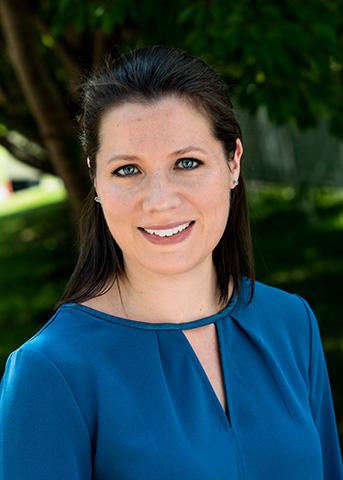For Christine Fennessey, Ph.D., HIV research is more than just a career—it’s the culmination of her passion for science and a desire to help people in need. And in just two years at the Frederick National Laboratory (FNL), her work has already gained the attention of her peers and the greater scientific community.
Fennessey manages the Viral Evolution Core in FNL’s AIDS and Cancer Virus Program. The core comprises a small laboratory of four scientists, including Fennessey, who provide genetic sequencing and molecular biology support to scientists at FNL and other institutions.
As manager, Fennessey is a scientific “jack of all trades” who does everything from interacting with collaborators to troubleshooting problems and analyzing data. As if that weren’t enough to keep her busy, she also works in the lab, performing research as part of the AIDS and Cancer Virus Program’s Retrovirus Evolution Section.
Fennessey found her love for science during a ninth-grade biology class taught by “Mr. Miller,” whose passion, knowledge, and enthusiasm rubbed off on his students.
“He inspired a spirit of curiosity and wonder about the natural world that has stuck with me all these years later,” Fennessey said of her all-time favorite teacher.
She first became interested in HIV during her undergraduate studies. One particular lecture, in which her professor described the disease, its severity, and the lack of a cure, remained with Fennessey into graduate school and her early career, eventually influencing her decision to join the AIDS and Cancer Virus Program.
“When the opportunity arose to work in an HIV-focused lab, I jumped at the chance to try and contribute some small tidbit of new knowledge which would help finally identify the key to unlocking the cure,” she said.
Last year, Fennessey, along with several coworkers and their collaborators at the University of New South Wales, published a paper describing a novel technique for inserting “barcodes” into the DNA of simian immunodeficiency virus (SIV), a pathogen that scientists use to study HIV because of its close relation to the human disease.
Each barcode consists of a small, unique series of meaningless nucleotide bases—the “rungs” in the “ladder” of DNA—that can be used to identify individual strands of SIV DNA in biopsies from infected monkeys. That allows researchers to measure the size of viral reservoirs in monkeys after halting antiretroviral therapy. (A viral reservoir is a group of infected cells that escape from the drugs and cause the infection to rebound to its full severity after treatment is stopped.) The resulting information is also useful for estimating reservoir sizes in HIV-infected humans, which can help scientists develop better treatments.
Fennessey was responsible for generating the barcoded virus, and she sees it as her proudest accomplishment at FNL. The paper recently won one of the Life Sciences and Medicine awards in the 2018 Leidos Technical Publications Competition. (Leidos is the parent company of Leidos Biomedical Research, Inc., which operates FNL on behalf of the National Cancer Institute.)
“The concept of a barcoded virus is novel and interesting, and I was excited to share this work with Leidos corporate, partly to show that even though we aren’t working on fighter jets or providing homeland defense like they are, Leidos Biomedical produces noteworthy work, too!” Fennessey said.
At last year’s International AIDS Society Conference on HIV Science, she also received the prestigious IAS/ANRS Lange-van Tongeren Prize for Young Investigators, Basic Science track, for an abstract describing the paper. The prize recognizes scientists younger than 35 whose work has demonstrated exemplary “innovation, originality, rationale, and quality.”
To Fennessey, however, the awards are just the icing on the cake. She loves what she does, and she is grateful to be working at a facility like FNL. Between the independent research environment, her intelligent and close-knit coworkers, FNL’s “stellar reputation,” and the meaningful work, the job often feels like the perfect place.
“Working here makes me feel like I’m contributing some small amount of good into the world, that my day-to-day efforts might actually make a positive impact on the lives of people infected with HIV,” she said.


